Learn Printmaking
Learning printmaking teaches us how to see in reverse. When the printing plate is inked and paper pressed down on it the image that is transferred is the reverse of what is on the plate. Many times the image result is a happy surprise or the image can look awkward or unbalanced because we tend to read and see things from left to right. In the transfer of the image (printing) the "left" of the image becomes the "right" and the "right" becomes the "left." Adjustments and changes have to be made to the printing plate to correct the unbalance and awkwardness.
Mono-printing is a one-time printing method--only one print is made from the print source which can be a painting on a smooth surface or a plate made from material like cardboard, mat board, plastic or metal. When the painting is completed, paper is pressed down on the painted surface and pulled away. Again, the same surprise factor is there and it can be either awkward/unbalanced or a joyful result. Mono-print is a vigorous, fun activity, especially for children. There is no carving into material (as there is with wood block or linoleum block) so the process is much easier for a child. The painting can be done on any smooth surface and produces exciting and often impressive results.
Multi-printing refers to a printing a plate that has a more permanent surface which allows repeated inking or painting to produce an image over and over.
Collagraph refers to a printing plate that is created by gluing down various textural materials like sandpaper, fabric, seeds, string, etc. When the glue is dry, the plate is sprayed or painted with shellac, varnish or polyurethane resin. When dry, this plate can be inked or painted with many colors. Pressing paper down on its surface records the textures so that a detailed imprint can be produced. Good quality sketch book paper or printing paper like rice paper holds up better for this process than copy paper.
Printmaking Supplies
A set of of acrylic paints or printing inks.
A paper plate or palette
A synthetic or bristle brush
A smooth surface like a plate, glass or plexiglass
Paper towels
Sketch book paper, printing paper like rice paper or copy paper.
A plastic water container
Card board or mat board
A collection of materials for the collagraph plate: sandpaper, seeds, beans, lace, fabric, nylon or metal. screen, straws, grasses, leaves, sand, cardboard pieces, etc.
Elmer's glue
Fabric (muslin or sheeting is recommended)
An iron
Most of these materials can be easily purchased online or at your favorite art supply store.
Lesson One: Make And Print A Monoprint
Lesson Two: Make And Print A Collagraph Plate
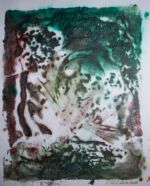
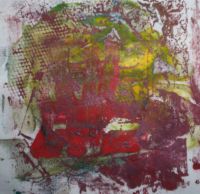
Collagraph print
By Lois DeWitt
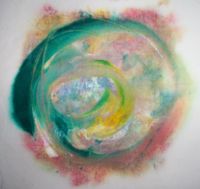
Collagraph print
By Lois DeWitt
Lesson Three: Print Fabric
Lesson Four: Print Fabric From A Collagraph Plate
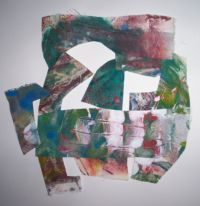
Printed Fabric Collage
By Lois DeWitt
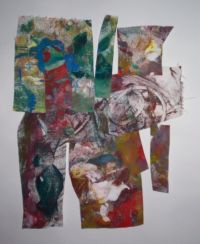
Printed Fabric Collage
By Lois DeWitt
Real Feedback
9/11/13
Hi Lois, thought I would send you a quick note to tell you how much I appreciate your YouTube videos. I found you last December when I purchased a Breville smart oven. I'd never really used a toaster oven for anything other than toast and since finding you I've been cooking like crazy! My husband thinks that's wonderful. Also I introduced my daughter to your art lessons and she is delighted, especially with the stencil one of the fishes! You encourage people of all skill levels to feel less intimidated by the thought of actually 'doing' a painting! Anyway, just saying thank you and to let you know how much we enjoy Charlie as well. Kindest regards, Carol
Hello Lois. Thanks for giving me the opportunity to learn hoy to draw and paint in diferentes styles and techniques. I just started and I've never had taken any classes til now with your tutorial. I really worldwide appreciate your comments about my still life exercise. I specially have problems with shading the table and painting the wood graining (as you can se in the picture) and also the table cloth. The melon sas difficult too, I feel something is missing there too . (Some things in the picture I didn't want them to apear in my painting) I'm starting to work with the landscape. As son as I have ir done I'll send you the picture. Best regards and thank you again.
Andrea Berkefeld (from México)
We did some printmaking at summer camp and I loved it! I found your website and me and my friend, Jen are making greeting cards for fund raising at school. thanks,
Tiffany Hodges
The origins of printmaking - Wikipedia
Printmaking is the process of making artworks by printing, normally on paper. Printmaking normally covers only the process of creating prints with an element of originality, rather than just being a photographic reproduction of a painting. Except in the case of monotyping, the process is capable of producing multiples of the same piece, which is called a 'print'. Each piece produced is not a copy but considered an original since it is not a reproduction of another work of art and is technically (more correctly) known as an 'impression'. Printmaking (other than monotyping) is not chosen only for its ability to produce multiple copies, but rather for the unique qualities that each of the printmaking processes lends itself to.
Prints are created by transferring ink from a matrix or through a prepared screen to a sheet of paper or other material. Common types of matrices include: metal plates, usually copper or zinc, or polymer plates for engraving or etching; stone, aluminum, or polymer for lithography; blocks of wood for woodcuts and wood engravings; and linoleum for linocuts. Screens made of silk or synthetic fabrics are used for the screenprinting process. Other types of matrix substrates and related processes are discussed below.
Multiple impressions printed from the same matrix form an edition. Since the late 19th century, artists have generally signed individual impressions from an edition and often number the impressions to form a limited edition. Prints may also be printed in book form, such as illustrated books or artist's books.
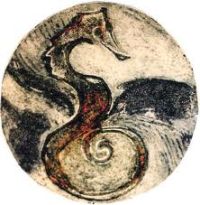
Buddhist-pics collagraph
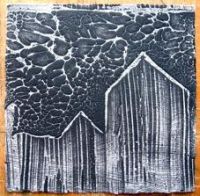
Collagraph by Dina Petrillo
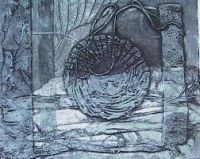
Collagraph by Suzanne Clark